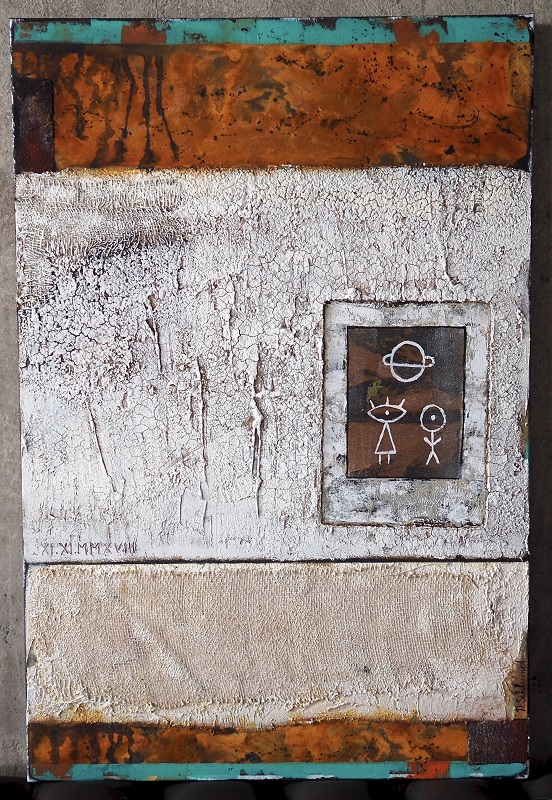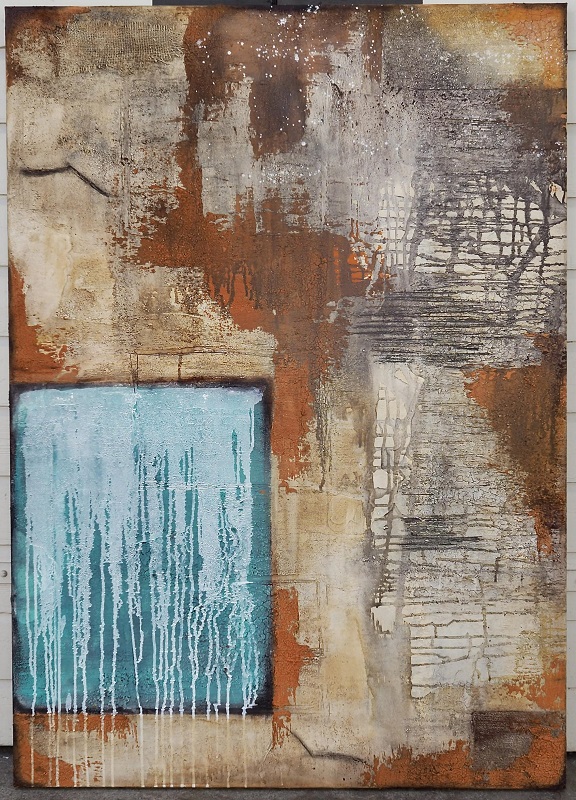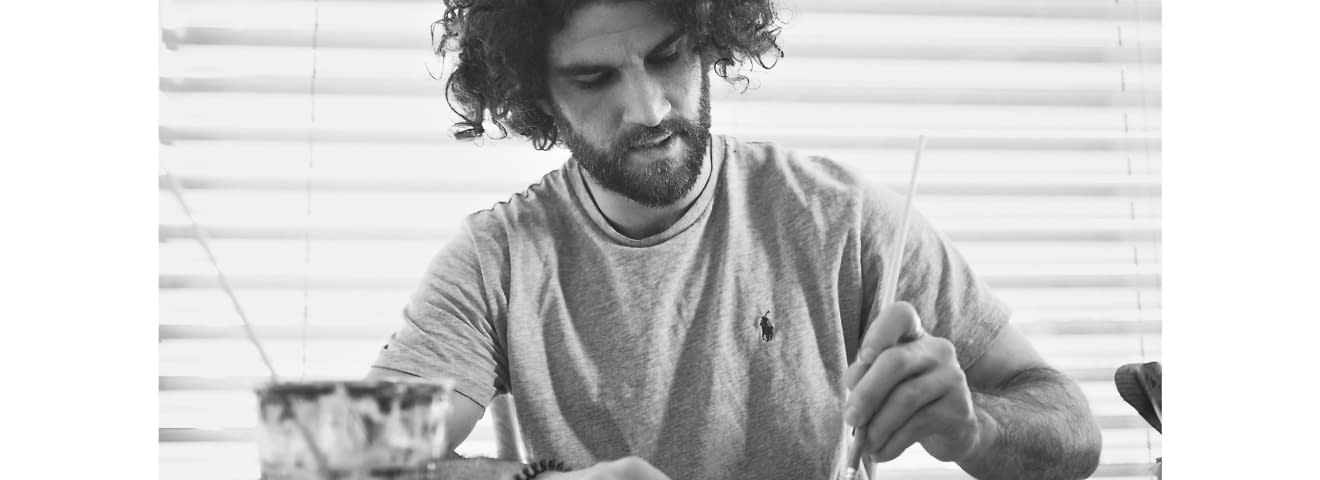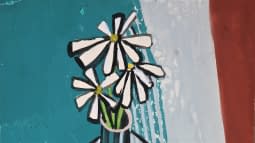Dominik Schlumpf: Ice hockey player at EVZ very personal as an artist
The conversation begins as soon as we enter the studio. No wonder. The colours, the pictures hanging on the walls or lying on the floor, 1000 questions are buzzing through the air!
C: Dominik, which is your favourite area in the studio?
D: It's with the materials, with the stone flours. My favourite instrument is the spatula. With it I can apply colours, pigments and different stone powders, scrape the surface to create a depth effect by scratching the stone powder. I learned everything by myself. Learned from books. Never went to an art school or attended classes. I am self-taught and learn by experimenting. For example, I use stone powder. Then the coffee grounds as a base, the marble powder on top. The coffee grounds work well to remove the moisture and to give the colour. This creates extreme cracking in the stone powder. Together with the marble powder, this then looks like birch in nature. With the spatula I scratch into it, I destroy it. This also simulates birch bark / fibre cracks.
C: Do you have a ritual for your artistic work? Or do you come into the studio, close the door and start?
D: I'm not in the studio daily. We have training six times a week plus two to three matches. Sunday is our rest day. Depending on the load, Wednesday is more of a lighter day doing weight training off the ice. If I have time, I go to the studio after training. Then I can devote myself completely to the art there and completely immerse myself in my paintings. Because I don't go to the studio every day, I know which ideas I want to implement and I'm eager to do so. I see this as an advantage, so when I have the time, I go and start working right away.
C: Willpower and self-control are two key strengths that you need to have as an artist but also as an athlete. Education and training are important for both. Sven Güldenpfennig (a German sports scientist) identifies four points as to what sport is. One of them is: Sport is performance-based - It strives for excellence, perfection, completeness. How and where do you see this in your art?
D: I see perfection in my art rather in the imperfect. Not everything has to be painted perfectly. The imperfect is what defines my works. In the imperfection lies beauty.
C: Güldenpfennig's second point is that the body is the medium. The body has limitations. One always wants more and more. And you once said creativity is limitless. Are you looking for a challenge or for the unknown? Are you always looking for something new?
D: Yes, definitely. I'm always open to new things and always on the lookout for certain things that I don't know yet and that I can then try out on a paper to see how that results and how I can then bring it onto the canvas.
C: What role does your body play in your work? In sports it is a tool and a central component. In your art?
D: No, my body is hardly strained. I also don't feel any fatigue when I'm working on a painting, even if it's four, five, six hours. I'm in a different world then. The fatigue may only come when I'm at home in the evening.
C: You forget time on the ice, too.
D: Yes, definitely, it's exactly the same during the matches. You don't notice what's happening around you, it's like being in a tunnel, the focus is only on the game, on what you have to do, you forget everything around you.
C: What was the last thing you discovered?
D: It's what you see in the pictures now. I'm primarily working on those. Stone powder, sand, cardboard, then I try to bring the effect of depth to appear. To make all the layers of the images visible. But I have not discovered anything super new at the moment. Or I rediscover things all over again. I once worked on a series with shutters. There, I worked with paper and recreated the shutters that way.
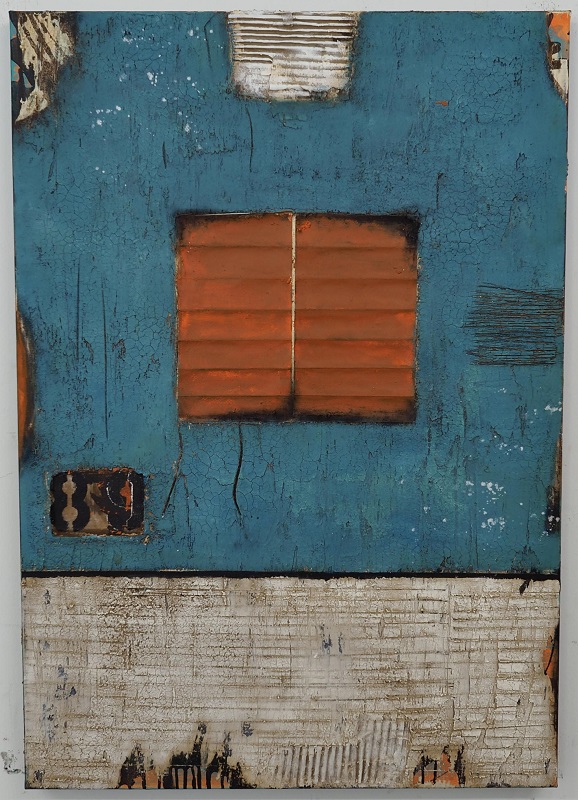
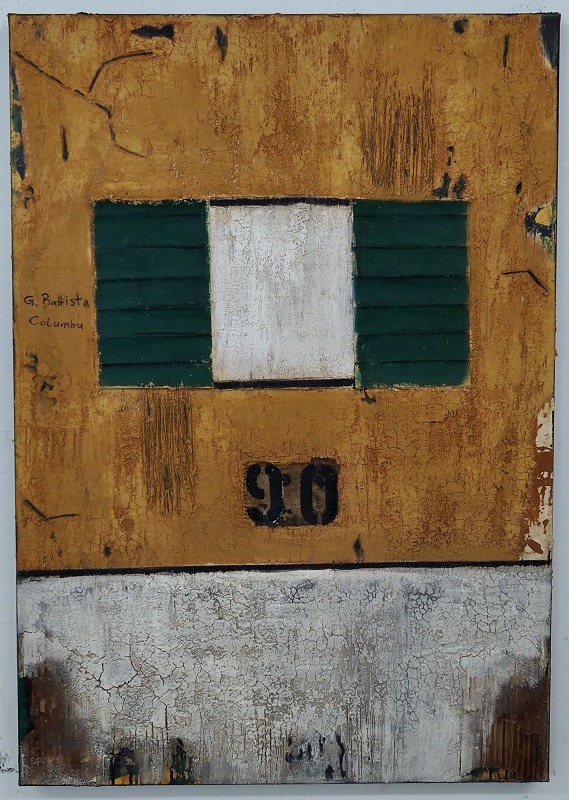
C: It is your trademark: To lead us as viewers:inside behind the light. Just when you think you've got your work figured out, you're proven wrong. Caillois, a French sociologist, sets out five laws of a game in a game theory. One of them is mimicry, trickery, play, masking. I see that a lot with you. Your works are irritating, it looks like something specific, but that is deceptive. It looks like bark or metal that oxidizes. Instead, you take iron powder and then go over it with oxidizer. Another law is that the outcome of the game is always unpredictable. Chance plays a big role. What kind of person are you when you are on the ice? Are you rather reserved? Or are you prudent and keep the overview?
D: I certainly think so, yes, but I also put myself fully at the service of the team and am a hard worker on the ice.
C: That means you dissolve, there is no Dominik as an individual anymore and you put yourself into the game where you are needed.
D: Exactly, it's certainly always the goal for me to see how I can best help the team so that the team will be successful and that we as a group are strong in order to achieve the goal. I put myself fully at the service of the team. Everyone has their role and if everyone accepts their role and performs it perfectly, you may get the success at the end of the season or achieve your goals.
C: And you as an individual artist, without being a member of an artist group, even alone in the studio. What advantage do you draw from this?
D: I like the silence very much. When I'm painting, I don't listen to music. It has to be quiet so that I can concentrate on what I'm doing, so I can give my ideas free rein. Here I am also very calm.
C: Are your paintings your team members? Or are you the boss here?
D: I wouldn't say it like that. There were situations where I just wanted to let something happen and I slept on it for a night and the next day it looked completely different. But then I liked it. Chance played into it and I left it that way. And on the other hand, I corrected other things that I didn't like.
C: Chance is a big factor in art, but also in sports. In art it can be a positive element, in sports it's something to be reckoned with.
D: That's exactly what you can't foresee in sports, you have to try to keep calm and the longer you play, the more experienced you become. So you have an answer for unexpected things. I can partly apply the same thing to my painting, including staying calm and maintaining patience. Initially, I was also impatient with the materials because I first had to find out how they worked. For example, with this marble flour which I wanted to treat again too soon, because I just had an idea. But it had not yet dried properly and not the way I wanted. It wouldn't hold properly on the canvas. I had to learn to be patient and let it rest for a night, and then continue working on it.
C: Where do your ideas come from?
D: I often find inspiration on long bus rides when we go to matches. It comes to me while looking out the window, wandering around, it can complement existing works or give rise to new ideas.
C: Art can be effective as an agency of realization. Can hockey/sports do that too? Hans Georg Gadamer (a German philosopher) refers to the game as an experience of art. «The game has an essence of its own, independent of the consciousness of those who play.» The game becomes a work of art through the transformation into the structure and what is now is the lasting true, the experience of the spectator. So, after the game is finished, everything is as it was, which is also what Caillos meant. So only the spectators or the viewers make the play or work what it is. What do you wish for your works?
D: I am very humble here and want the viewer to have a lifetime of pleasure from the picture and to pass on the feelings he felt when he looked at it. This gives me the most satisfaction.
C: Thank you very much for your time and trust.
Note: Rust is a kind of self-protection as well. It permeates Dominik's work. But he lets it rust and stops it again. Just as he feels it is right. Is it just me who sees the parallels to his hockey game? It was a wonderful conversation.
